What You Need To Know About Microgreens – 9 Incredible Health Benefits of this Sprout and Easy to Grow Your Own
The Health Benefits of Growing and Consuming Microgreens
Overview
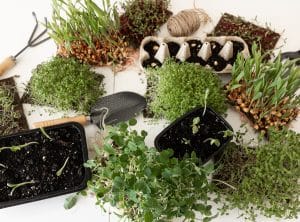
A Brief History of Growing Microgreens
Microgreens, though a recent health food trend, have roots that trace back several decades. These tiny, nutrient-dense greens have evolved from culinary curiosities to a mainstream superfood, praised for their versatility, flavor, and concentrated nutrients.
Early Beginnings: The Sprout Connection
The concept of growing small greens for consumption likely originated from the ancient practice of cultivating sprouts, which dates back to 3000 BCE in China and India. Sprouts, like mung beans, lentils, and alfalfa, were popular in early Chinese medicine due to their nutritional benefits and healing properties. While sprouts are technically different from microgreens (as they are harvested at a different stage of growth), their use set the stage for the development of microgreens later on.
Microgreens Emerge: 1980s in California
Microgreens, as we know them today, began to emerge in the 1980s in Southern California. Known as the hub of farm-to-table cuisine, California was the breeding ground for innovative chefs looking for new flavors, textures, and visual elements to enhance their dishes. In high-end restaurants, chefs began to experiment with harvesting seedlings of vegetables and herbs shortly after their first leaves emerged, using them as garnish to elevate the presentation and taste of their plates.
At this time, the types of these greens cultivated were limited, focusing primarily on varieties like arugula, cilantro, beet greens, and basil. These greens were appreciated for their distinct flavors and delicate appearance, adding freshness and color to gourmet dishes.
Growth in Popularity: The 1990s and Early 2000s
Throughout the 1990s and into the early 2000s, microgreens began to grow in popularity, expanding beyond fine-dining restaurants. Their use spread across the United States and eventually into Europe and Asia. The growing interest in farm-to-table movements and organic, sustainable eating contributed to the rising demand for these tiny greens.
During this time, more research into these greens began to emerge, shedding light on their nutritional density. A 2012 study conducted by the U.S. Department of Agriculture found that microgreens can contain significantly higher concentrations of vitamins and antioxidants than their mature vegetable counterparts. This revelation, coupled with the increasing awareness of healthy eating, positioned these greens as more than just a garnish—they were now recognized for their potent health benefits.
Home Growing and Mainstream Appeal: The 2010s to Today
By the 2010s, the trend of growing microgreens at home began to take off. With more people becoming aware of the benefits of eating fresh, organic produce and the ease with which these greens could be cultivated, small-scale home gardening became increasingly popular. The rise of urban farming and sustainable agriculture practices also contributed to the spread of these greens as a practical and eco-friendly option for city dwellers.
Microgreens offered a solution for individuals with limited space and resources who still wanted to grow their own food. From windowsill planters to indoor hydroponic systems, people could harvest fresh, nutrient-dense greens in just a couple of weeks.
Today, these greens have moved from restaurant menus to supermarket shelves, farmers’ markets, and home kitchens. With a wide variety of seeds available, people can now grow sprouts from kale, radishes, peas, sunflowers, mustard greens, and even broccoli. Their versatility and health benefits have cemented their place in modern diets.
The history of microgreens is relatively short, yet their journey from culinary garnish to health-boosting superfood reflects larger trends in sustainable, healthy eating. From their beginnings in high-end California kitchens to their current status as a staple in homes and restaurants around the world, microgreens represent a unique fusion of nutrition and culinary innovation. As interest in urban farming and eco-friendly practices continues to grow, the popularity of microgreens is only expected to rise.
Microgreens, the young shoots of vegetables and herbs harvested at an early stage, pack a powerful nutritional punch. Although they are small, these greens contain higher concentrations of vitamins, minerals, and antioxidants compared to their mature counterparts. They are increasingly recognized as a superfood due to their rich nutrient content, which varies slightly depending on the type of microgreen grown. Below is an overview of the nutritional profile of these greens, supported by scientific research.
Nutritional Components of Microgreens
- Vitamins
Microgreens are particularly rich in vitamins, including:
- Vitamin C: Microgreens, especially varieties like red cabbage, are excellent sources of vitamin C, which is vital for immune function, collagen synthesis, and skin health.
- Vitamin K: Found in high concentrations in leafy microgreens like kale and spinach, vitamin K is essential for blood clotting and bone health.
- Vitamin E: Microgreens like radishes and sunflowers contain significant amounts of vitamin E, an antioxidant that protects cells from oxidative damage.
- Vitamin A (Carotenoids): Carotenoids such as beta-carotene are abundant in these greens, especially those from the Brassica family (e.g., kale, and broccoli). Vitamin A is essential for vision, skin health, and immune function.
- Minerals
Microgreens provide a variety of essential minerals, including:
- Iron: Microgreens like amaranth are a good source of iron, which is crucial for oxygen transport in the blood.
- Calcium: Calcium, important for bone health, is present in these greens such as basil and kale.
- Magnesium: Found in these greens like spinach, magnesium is essential for muscle and nerve function, blood pressure regulation, and enzyme activity.
- Zinc: Microgreens like cilantro and radish are good sources of zinc, which is important for immune function, DNA synthesis, and wound healing.
- Antioxidants
Microgreens are exceptionally high in antioxidants, compounds that help neutralize free radicals and reduce oxidative stress, potentially lowering the risk of chronic diseases such as cancer, heart disease, and diabetes.
- Flavonoids: Present in these greens such as red cabbage and radish, flavonoids have anti-inflammatory and antioxidant properties that may help protect against cardiovascular diseases.
- Polyphenols: Microgreens are rich in polyphenols, which possess anti-inflammatory and anti-carcinogenic properties. These are especially abundant in darker varieties like purple mustard and beet microgreens.
- Glucosinolates: Found in Brassica microgreens (e.g., broccoli, kale), glucosinolates are sulfur-containing compounds that have been shown to reduce the risk of certain cancers by promoting detoxification enzymes.
- Protein
Although microgreens are not typically considered a high-protein food, certain types, such as pea shoots and sunflower microgreens, contain moderate amounts of protein. The protein content in microgreens can contribute to overall dietary intake, especially for those on plant-based diets.
- Amino Acids: Some microgreens contain all nine essential amino acids in small amounts, making them a good complement to other plant-based protein sources.
- Fiber
While these greens are not consumed for their fiber content due to their small size, they still contribute to daily fiber intake. Consuming microgreens raw, as part of salads or sandwiches, can support digestive health.
- Fats
These greens contain minimal fat, but some varieties, such as sunflower microgreens, provide small amounts of healthy fats, particularly omega-3 fatty acids, which are beneficial for heart health.
Nutrient Density Compared to Mature Greens
Studies have shown that microgreens can have up to 4 to 40 times higher nutrient concentrations than their fully grown counterparts. For example, a study published in the Journal of Agricultural and Food Chemistry found that red cabbage microgreens had 6 times more vitamin C and 40 times more vitamin E than mature red cabbage. Broccoli microgreens, for example, are known to have higher levels of sulforaphane, a potent antioxidant, compared to mature broccoli.
Health Benefits Associated with Microgreens
Due to their rich nutrient profile, microgreens are associated with various health benefits:
- Cardiovascular Health: The high levels of antioxidants and polyphenols in these greens can help lower cholesterol levels and reduce the risk of heart disease.
- Cancer Prevention: Glucosinolates, especially in Brassica microgreens like broccoli, may help reduce the risk of certain cancers by supporting detoxification processes.
- Immune Support: Vitamin C and zinc, both found in these greens, are vital for maintaining a strong immune system.
- Eye Health: Carotenoids like beta-carotene found in these greens support eye health and may help prevent age-related macular degeneration.
- Bone Health: Vitamin K and calcium are crucial for bone health, and their presence in these greens can help maintain bone density and reduce the risk of fractures.
Microgreens offer a nutrient-dense food option that packs more vitamins, minerals, and antioxidants than many mature vegetables. With their high concentrations of essential nutrients, these greens can play an important role in promoting overall health and preventing chronic diseases when incorporated into a balanced diet.
Microgreen Therapeutic Compounds
Microgreens are rich in various therapeutic chemical compounds that contribute to their health benefits. These compounds include vitamins, minerals, antioxidants, and bioactive phytochemicals that promote wellness and protect against diseases. Below is a list of key therapeutic compounds found in these greens, along with their health-promoting properties.
- Polyphenols
Polyphenols are powerful antioxidants found in high concentrations in microgreens, particularly in varieties like red cabbage, cilantro, and radish. These compounds help to combat oxidative stress and inflammation, which are linked to chronic diseases such as cancer, cardiovascular diseases, and neurodegenerative disorders.
- Quercetin: Found in cilantro and onion microgreens, quercetin is known for its anti-inflammatory and antioxidant effects. It may help reduce blood pressure, lower LDL cholesterol, and protect against heart disease.
- Anthocyanins: Red cabbage microgreens are especially rich in anthocyanins, which give them their vibrant color. These compounds are linked to improved heart health, reduced cancer risk, and better brain function.
- Vitamins
Microgreens are dense in essential vitamins, which support various biological functions:
- Vitamin C: Common in broccoli and mustard microgreens, vitamin C boosts immune function, enhances skin health, and acts as a potent antioxidant to neutralize free radicals.
- Vitamin E: Present in sunflower and radish microgreens, vitamin E protects cell membranes from oxidative damage and is beneficial for skin health, immune response, and vision.
- Vitamin K: Found in kale and arugula microgreens, vitamin K plays a crucial role in blood clotting, bone health, and heart health.
- Minerals
Microgreens are rich in essential minerals, contributing to their overall therapeutic potential.
- Potassium: Present in sunflower and pea microgreens, potassium supports heart health, muscle function, and fluid balance in the body.
- Iron: Found in spinach and beet microgreens, iron is essential for producing hemoglobin, the protein in red blood cells that carries oxygen to the body’s tissues.
- Calcium: Microgreens like broccoli and cabbage contain calcium, which supports bone health, muscle function, and nerve signaling.
- Carotenoids
Carotenoids are pigments that give these greens their color and have significant antioxidant properties. They protect cells from damage and are associated with improved vision, skin health, and reduced cancer risk.
- Beta-carotene: Found in sprouts such as carrot and basil, beta-carotene is converted into vitamin A in the body, which is vital for maintaining healthy vision, skin, and immune function.
- Lutein and Zeaxanthin: Present in spinach and kale microgreens, these carotenoids support eye health by protecting against age-related macular degeneration and cataracts.
- Glucosinolates
Glucosinolates are sulfur-containing compounds found in cruciferous microgreens, such as broccoli, kale, mustard, and radish. These compounds are known for their potential anticancer properties. When consumed, glucosinolates are broken down into biologically active compounds like sulforaphane, which has been shown to:
- Inhibit cancer cell growth
- Promote detoxification enzymes
- Protect against DNA damage
Sulforaphane, particularly abundant in broccoli microgreens, is also linked to anti-inflammatory, neuroprotective, and antimicrobial properties.
- Flavonoids
Flavonoids are a group of plant-based antioxidants that protect cells from oxidative damage and have anti-inflammatory properties.
- Kaempferol: Found in spinach and broccoli microgreens, kaempferol has anti-inflammatory, anticancer, and cardiovascular benefits. It is known to promote apoptosis (programmed cell death) in cancer cells and reduce the risk of chronic diseases.
- Apigenin: Present in parsley microgreens, apigenin has antioxidant, anti-inflammatory, and anti-carcinogenic properties, and may protect against certain types of cancer.
- Fiber
Though these greens are tiny, they still provide a good source of fiber, especially insoluble fiber, which supports digestive health, regulates blood sugar, and promotes satiety. Insoluble fiber is essential for healthy bowel movements and preventing digestive disorders like constipation and diverticulosis.
- Omega-3 Fatty Acids

Microgreens are packed with a wide range of therapeutic compounds, making them a valuable addition to a healthy diet. From potent antioxidants like polyphenols and carotenoids to essential vitamins, minerals, and bioactive phytochemicals like glucosinolates, these tiny greens provide significant health benefits. Incorporating these greens into your daily meals can help support immune function, heart health, skin health, and even offer protection against chronic diseases.
Health Benefits of Microgreens
- Rich in Nutrients
Microgreens are often referred to as “superfoods” due to their concentrated nutrient content. Studies show that these greens can contain up to 40 times more nutrients than their mature counterparts. They are especially rich in:
- Vitamins: Microgreens, such as red cabbage and cilantro, contain high levels of vitamins A, C, and E, which are essential for immune function, skin health, and vision.
- Minerals: They are abundant in minerals like potassium, magnesium, iron, and calcium, which support bone health, muscle function, and cardiovascular wellness.
- Antioxidants: Many microgreens are loaded with powerful antioxidants, including polyphenols and flavonoids, which help neutralize harmful free radicals, reducing the risk of chronic diseases.
- Support Heart Health
Consuming these greens can have a positive impact on heart health. They are rich in phytonutrients that help reduce LDL (bad) cholesterol levels, improve blood pressure, and support overall cardiovascular health. For instance, red cabbage microgreens have been shown to help lower cholesterol and reduce inflammation, both of which are linked to heart disease.
- Improve Digestive Health
Microgreens contain a good amount of fiber, particularly insoluble fiber, which helps to regulate digestion and promote healthy bowel movements. Additionally, the enzymes present in these greens may assist in breaking down food, enhancing nutrient absorption, and easing digestive processes.
- Boost Immune Function
Microgreens like broccoli and radish are high in vitamin C, which plays a vital role in supporting the immune system. Vitamin C enhances the production of white blood cells, which are essential for fighting off infections. Furthermore, the antioxidants in these greens help protect the immune system from oxidative stress, contributing to stronger immune defense.
- Aid in Weight Management
Microgreens are low in calories but incredibly nutrient-dense, making them an excellent choice for those looking to manage their weight. Their high fiber content promotes satiety, helping to control appetite and reduce overeating. Adding these greens to meals can enhance nutritional value without significantly increasing calorie intake.
The antioxidants, vitamins, and minerals found in these greens can also benefit skin health. Vitamin E is known for its ability to protect the skin from oxidative damage and reduce signs of aging, such as wrinkles and fine lines. Vitamin C supports collagen production, which keeps the skin firm and youthful.
- Anti-Cancer Properties
Many microgreens, particularly broccoli microgreens, contain sulforaphane, a compound that has been shown to possess anti-cancer properties. Research suggests that sulforaphane helps protect cells from DNA damage, inhibits tumor growth, and induces cancer cell death. Consuming these greens regularly may help lower the risk of cancer.
- Convenient and Easy to Grow
One of the major advantages of microgreens is how easy they are to grow at home. They require minimal space, can be grown indoors, and typically reach harvest within 1-3 weeks. This makes them an accessible option for anyone looking to incorporate fresh, nutritious greens into their diet without the need for a large garden or extensive gardening experience.
- Sustainable and Eco-Friendly
Growing your own greens is not only good for your health but also beneficial for the environment. Microgreens require far less water, soil, and energy compared to traditional agriculture. Since they are grown and consumed locally, they also help reduce the carbon footprint associated with food transportation and storage.
How to Grow Your Own Microgreens at Home Organically and How to Use Them
Growing these greens at home is an easy and rewarding way to access fresh, nutrient-dense greens. These tiny plants are packed with vitamins, minerals, and antioxidants and can be grown in small spaces, making them ideal for urban settings or anyone interested in sustainable home gardening. In this guide, we will explore how to grow your own microgreens organically and offer tips on how to incorporate them into your meals.
Why Grow Microgreens Organically?
Organic microgreens are free from harmful pesticides and synthetic fertilizers, making them healthier for both you and the environment. By growing these greens organically, you also maintain control over the growing process, ensuring the purity and nutritional quality of your greens.
What You Need to Grow Organic Microgreens
Growing these greens doesn’t require a lot of space or equipment. Here’s what you’ll need:
- Seeds: Choose organic, non-GMO seeds. Popular varieties of microgreens include:
- Broccoli
- Radish
- Kale
- Peas
- Sunflower
- Arugula
- Basil
- Cilantro
- Growing Tray: Use a shallow, food-safe tray with drainage holes. You can find trays specifically designed for microgreens, or repurpose a shallow dish.
- Organic Potting Soil: Select high-quality, organic potting soil. Avoid soils with chemical fertilizers or additives. Alternatively, you can use organic seed-starting mixes or coconut coir.
- Water: Use filtered or distilled water to ensure there are no chemicals like chlorine that may affect plant growth.
- Sunlight: Place the tray in an area that receives plenty of natural sunlight (4-6 hours a day) or use grow lights to provide the necessary light.
- Spray Bottle: For watering, a spray bottle works best for evenly moistening the delicate microgreen seedlings.
Step-by-Step Guide to Growing Microgreens Organically
- Prepare the Tray
- Fill the tray with about 1-2 inches of organic potting soil. Pat it down gently to create an even surface.
- Ensure the soil is slightly moist, but not soggy.
- Sow the Seeds
- Evenly scatter your organic seeds across the surface of the soil. You can sow the seeds densely, as microgreens do not need much space to grow.
- Gently press the seeds into the soil using your hand or a small board to ensure good seed-to-soil contact.
- Lightly cover the seeds with a thin layer of soil or leave them uncovered, depending on the type of seed (some varieties like radish don’t need to be covered).
- Water the Seeds
- Use the spray bottle to mist the seeds, ensuring the soil is moist but not waterlogged.
- Continue to mist the seeds once or twice a day to maintain moisture levels.
- Provide Light
- Place the tray in a sunny window or under grow lights. Microgreens need around 4-6 hours of light daily to grow properly.
- If you’re using natural sunlight, rotate the tray daily to ensure even light distribution.
- Maintain Humidity and Moisture
- Keep the soil moist throughout the growing process, but avoid overwatering, which can lead to mold growth.
- Some gardeners use a humidity dome or plastic wrap to cover the tray during the initial few days to promote faster germination. Once the seeds sprout, remove the cover to prevent mold.
- Harvest the Microgreens
- Microgreens are typically ready for harvest in 7-21 days, depending on the variety. They are ready when they have grown their first set of true leaves (about 2-3 inches tall).
- To harvest, use scissors to snip the greens just above the soil line.
- Rinse and Store
- After harvesting, rinse the greens gently with cold water to remove any soil.
- Store them in an airtight container in the fridge, where they can last for up to a week.
Using Microgreens in Your Diet
Microgreens are highly versatile and can be added to a variety of dishes to boost flavor and nutritional value. Here are some delicious ways to incorporate these greens into your meals:
- Salads:
- Microgreens make a great base or garnish for salads. Mix different varieties for a burst of flavor, color, and nutrients.
- Smoothies:
- Add a handful of these greens, such as kale or spinach microgreens, to your smoothies for an extra dose of vitamins and antioxidants.
- Sandwiches and Wraps:
- Layer microgreens in sandwiches, burgers, and wraps for a fresh, crunchy texture and peppery flavor.
- Toppings:
- Use these greens to garnish soups, pizzas, omelets, and stir-fries. They add a fresh, crisp element that elevates the dish.
- Juices:
- Certain sprouts like sunflower and pea greens can be juiced to add a nutrient boost to your daily intake.
- Pesto and Dips:
- Replace basil with these greens in your favorite pesto recipe, or blend them into dips like guacamole and hummus for a unique twist.
Growing your own sprouts at home is an easy, affordable, and environmentally friendly way to ensure you have access to fresh, nutrient-dense greens. With just a small tray and a bit of light, you can enjoy a harvest of organic sprouts in less than three weeks. Incorporating them into your meals adds a burst of flavor, texture, and valuable nutrients to your diet.
Common Dangers and Risks of Growing Microgreens
Growing your own greens can be an enjoyable and nutritious endeavor, but like any form of gardening, it comes with potential risks and precautions. Ensuring you follow proper growing practices is essential to prevent issues like contamination, mold, or nutrient imbalances. Below are some common dangers and precautions when growing sprouts at home, along with tips to minimize these risks.
- Contamination with Harmful Pathogens
Microgreens, like sprouts, are grown in moist environments, which can be ideal conditions for the growth of harmful bacteria such as E. coli, Salmonella, and Listeria. If contaminated seeds or soil are used, or if the greens are not handled properly, there’s a risk of foodborne illness.
- Risk: Bacterial contamination can cause food poisoning, leading to symptoms such as nausea, vomiting, diarrhea, and fever. Vulnerable groups such as children, pregnant women, the elderly, and immunocompromised individuals are at higher risk of serious illness.
- Mold Growth
Mold can easily grow in environments that are too humid or poorly ventilated, which is a common issue in indoor microgreen cultivation. Mold appears as a fuzzy white or black growth on the soil or the greens themselves.
- Risk: Mold can produce allergens, irritants, and in some cases, mycotoxins that can be harmful if inhaled or ingested. Mold exposure can cause allergic reactions or respiratory problems, particularly in people with asthma or allergies.
- Improper Watering
Overwatering or underwatering sprouts can negatively affect plant growth. Overwatering can lead to mold and root rot, while underwatering can cause the plants to wilt and fail to thrive.
- Risk: Root rot can kill the sprouts, and mold from overwatering can contribute to poor air quality in your home. Underwatered plants will lack the nutrients and growth necessary to yield healthy sprouts.
- Contaminated Soil
Using non-sterilized or contaminated soil can introduce pathogens, fungi, or harmful chemicals into your microgreen trays. If the soil is not organic, it may contain pesticides or herbicides that are harmful to health.
- Risk: Soil-borne diseases can affect plant health and lead to foodborne illnesses. Exposure to pesticides or herbicides can result in long-term health risks, including potential hormone disruption or toxicity.
- Nutrient Deficiencies
While sprouts are packed with nutrients, if you rely solely on them for a large portion of your diet without considering variety, you could miss out on certain key nutrients.
- Risk: Depending on the type of microgreen grown, you may have an imbalance in nutrient intake. For example, while sprouts are high in certain vitamins (like C and K), they might not provide sufficient amounts of protein, fat, or other essential nutrients required for a balanced diet.
Precautions for Growing Microgreens at Home
- Use Certified Organic and Non-GMO Seeds
Always purchase seeds that are certified organic and non-GMO. Organic seeds are less likely to contain harmful chemicals, and non-GMO seeds ensure that you are growing natural varieties.
- Precaution: Buy seeds from reputable sources, and make sure they are labeled for microgreen or sprouting purposes to reduce the risk of contamination.
- Sterilize Growing Trays and Tools
Before using trays, pots, or containers for growing these greens, thoroughly clean and sterilize them. Use a mild bleach solution (1 tablespoon bleach per gallon of water) to sanitize containers, then rinse thoroughly with clean water.
- Precaution: Regularly clean and disinfect all tools and containers between plantings to avoid cross-contamination.
- Use Organic, Sterile Soil or Growing Medium
Choose a high-quality, organic potting soil or growing medium that is sterile. Avoid using garden soil, which may harbor pests, pathogens, or chemicals. Alternatively, coconut coir or organic seed-starting mixes are good options for growing sprouts.
- Precaution: Avoid reusing soil from previous batches of sprouts to reduce the risk of contamination.
- Ensure Proper Ventilation
To prevent mold growth, ensure your sprouts are grown in a well-ventilated area. This reduces humidity and moisture buildup, which are key contributors to mold and fungal growth.
- Precaution: Use a small fan to improve air circulation if needed. Keep an eye on humidity levels, especially when using a humidity dome or growing indoors.
- Control Watering and Drainage
Maintain proper moisture levels by lightly misting the plants rather than overwatering. Ensure that the growing tray has drainage holes to prevent water from pooling at the bottom, which can lead to mold and root rot.
- Precaution: Water sprouts consistently but avoid making the soil too wet. Empty any excess water that collects in the bottom of the tray.
- Harvest at the Right Time
Microgreens are typically ready to harvest 7-21 days after sowing. Harvest them once the first set of true leaves appears, as leaving them for too long can increase the risk of mold or wilting.
- Precaution: Cut the sprouts just above the soil line using clean scissors. Avoid pulling them from the soil, as this can introduce soil particles and potential pathogens into your harvest.
- Store Microgreens Properly
After harvesting, rinse the sprouts in cold water to remove any residual soil. Dry them gently and store them in an airtight container in the refrigerator. Use them within 5-7 days to maintain freshness and prevent spoilage.
- Precaution: Don’t store wet microgreens, as moisture can encourage bacterial growth and spoilage.
- Rotate Crops and Clean Between Batches
After each harvest, discard the old soil and clean the trays thoroughly before starting a new batch. Rotating different types of sprouts can also help reduce the risk of nutrient depletion in the soil and pests or mold from persisting.
While growing these greens at home is generally safe and easy, it’s essential to follow precautions to avoid contamination, mold growth, and improper care. By using organic seeds, proper soil, and maintaining a clean growing environment, you can minimize the risks and enjoy a fresh, healthy harvest of nutrient-rich sprouts.
After Thoughts
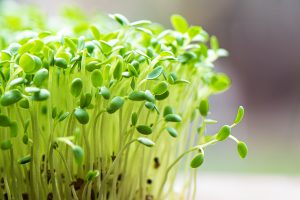
Start growing your own Microgreens today and consider adding Solaris from Activation Products into your daily health regimen to help start enjoying its health benefits and experience revitalized optimal health.
For natural and healing remedies, products, and supplements to help you live your most optimal healthy life, visit our store here!
Remember: Own Your Health!
If you enjoyed the information presented in this article, Please Share It. Help us reach more people and keep this website going! Thank you!
Note: The information provided in this article is for educational purposes only and should not be considered medical advice. Please consult with a healthcare professional or registered dietitian before making any significant changes to your diet or lifestyle.
Microgreens Frequently Ask Questions
- What are microgreens? Microgreens are young plants harvested just after the first true leaves (cotyledons) have developed, typically 7 to 21 days after germination. They are small, flavorful greens that can be grown from various vegetable, herb, and flower seeds.
- How do microgreens differ from sprouts? While both are young plants, these greens are grown in soil or a growing medium and are harvested when they are a few inches tall, whereas sprouts are germinated seeds that are usually grown in water and eaten whole, often without soil.
- What are the health benefits of microgreens? Microgreens are nutrient-dense and rich in vitamins, minerals, and antioxidants. They can support cardiovascular health, boost the immune system, improve digestion, and help with cancer prevention.
- How do I grow microgreens at home? To grow microgreens:
- Choose a suitable seed variety.
- Use a shallow tray with drainage holes.
- Fill the tray with organic potting soil.
- Sow seeds densely, mist with water, and cover lightly.
- Provide adequate light and moisture.
- Harvest when they are 2-3 inches tall.
- Do I need special equipment to grow microgreens? No special equipment is required. A shallow tray, organic soil, seeds, water, and a light source (natural or grow lights) are sufficient.
- How often should I water microgreens? Microgreens should be kept consistently moist but not soggy. Mist them once or twice daily to maintain humidity, and ensure proper drainage to prevent waterlogging.
- Are microgreens organic? Microgreens can be grown organically if you use organic seeds and soil, and avoid synthetic fertilizers and pesticides.
- Can I eat microgreens raw? Yes, these greens are typically consumed raw, adding flavor, texture, and nutrition to salads, sandwiches, smoothies, and garnishes.
- How long do microgreens last after harvesting? Fresh microgreens can last up to a week when stored in an airtight container in the refrigerator. For the best flavor and texture, consume them shortly after harvest.
- Can I grow microgreens indoors? Yes, microgreens can be easily grown indoors, making them ideal for urban dwellers or those with limited outdoor space. Ensure they receive adequate light and ventilation.
- Are there any risks associated with growing microgreens? Potential risks include contamination with harmful pathogens if proper hygiene practices aren’t followed, mold growth due to excess moisture, and using contaminated soil or seeds. It’s essential to use clean equipment and organic materials.
- How do I know when to harvest microgreens? Microgreens are typically ready to harvest when they are 2-3 inches tall and have developed their first true leaves. Use scissors to cut them just above the soil line.
- What types of seeds are best for microgreens? Popular microgreen seeds include:
- Broccoli
- Radish
- Kale
- Pea
- Sunflower
- Arugula
- Basil
- Mustard
- Can I grow microgreens year-round? Yes, these greens can be grown year-round, making them a great option for fresh greens regardless of the season.
- What are some creative ways to use microgreens in cooking? Microgreens can be added to salads, smoothies, soups, sandwiches, and wraps. They can also be used as a garnish for various dishes to enhance flavor and presentation.
References
- Xiao, Z., Lester, G. E., Luo, Y., & Wang, Q. (2012). Assessment of vitamin and carotenoid concentrations of emerging food products: Edible microgreens. Journal of Agricultural and Food Chemistry, 60(31), 7644–7651.
- Treadwell, D. D., Hochmuth, R., & Simonne, E. (2016). Microgreens: A New Specialty Crop. University of Florida IFAS Extension.
- Sun, J., Ma, Y., Chen, J., & Wang, F. (2013). Antioxidant activity of extracts from edible microgreens. Journal of Functional Foods, 5(2), 786–789.
- Choe, U., Yu, L. L., & Wang, T. T. (2018). The science behind microgreens as an emerging functional food: Their nutritional value, phytochemical composition, and biological activities. Journal of Food Science, 83(3), 383-392.
- Kopsell, D. A., Sams, C. E., & Barickman, T. C. (2012). Microgreens: Nutrient dynamics during seedling development. HortScience, 47(9), 1103-1106.
- Fahey, J. W., & Talalay, P. (1999). Antioxidant and anticarcinogenic activities of sulforaphane: A potent inducer of enzymes that protect against chemical carcinogenesis. Proceedings of the National Academy of Sciences, 96(5), 1763–1768.
- United States Department of Agriculture. (2012). Nutrient concentrations in microgreens: A comparative study with mature vegetables. Journal of Agricultural and Food Chemistry, 60(31), 7644–7651.
- Yadav, A. K., & Tripathi, R. M. (2017). Microgreens: An emerging trend in agriculture. International Journal of Current Microbiology and Applied Sciences, 6(10), 353-361.
- Wadhera, D., & Capaldi Phillips, E. D. (2016). A review of the health and culinary uses of microgreens. Journal of Food Science and Technology, 53(4), 2423-2432.
- USDA National Nutrient Database. (2020). Nutrient profile of microgreens. Retrieved from usda.gov
- Fahey, J. W., & Kensler, T. W. (2013). The broccoli sprout and its potential for cancer prevention. Cancer Prevention Research, 6(7), 646-656.
- University of California Agriculture and Natural Resources. (2020). Growing Microgreens at Home. Retrieved from ucanr.edu
- Centers for Disease Control and Prevention (CDC). (2019). Microgreens: Know the Risks and Precautions. Retrieved from cdc.gov

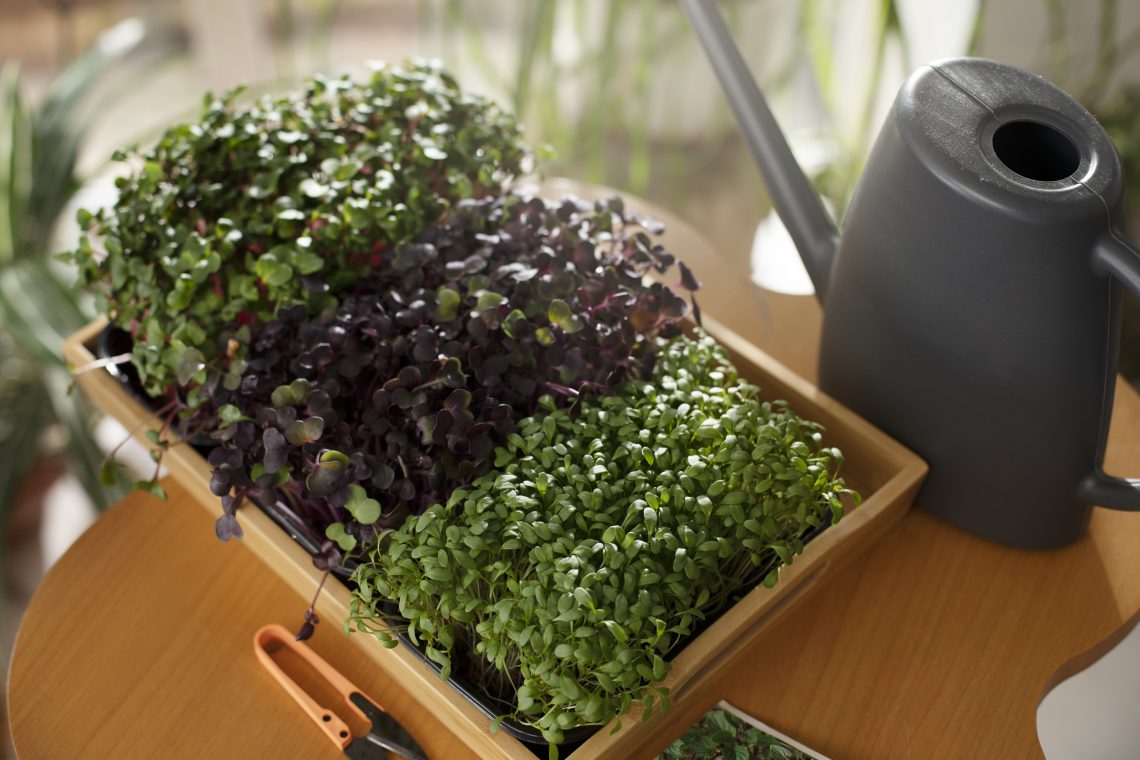







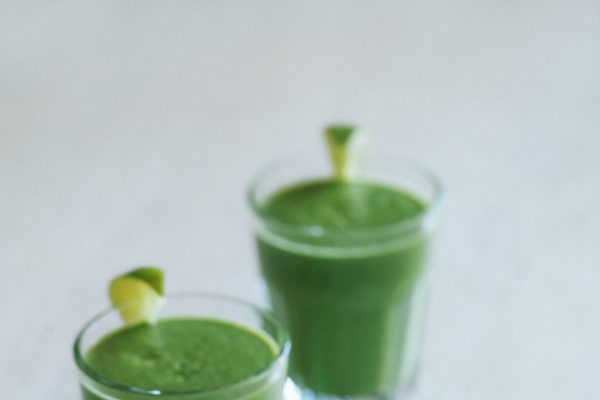
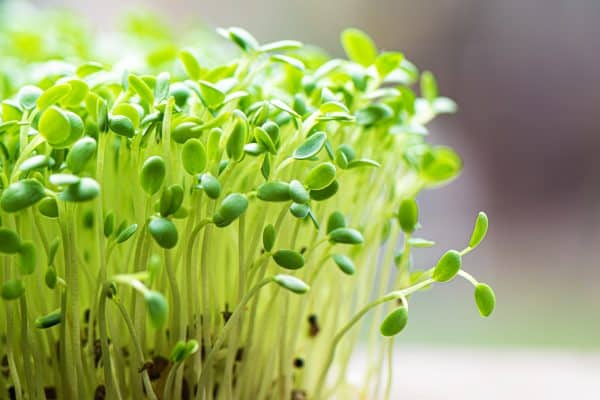


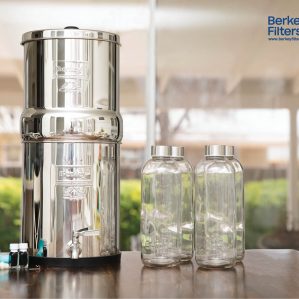

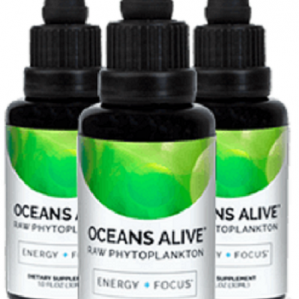













0 Comment